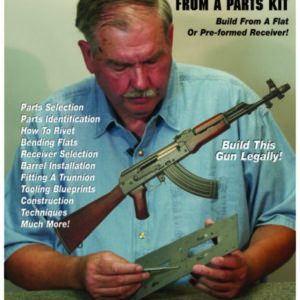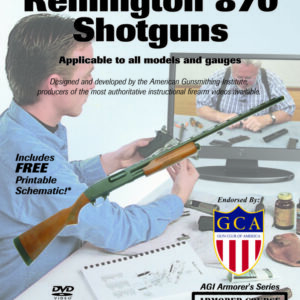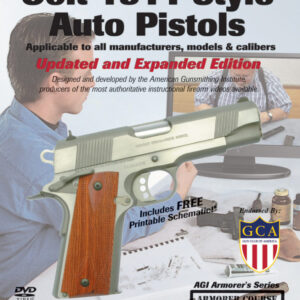Description
The Belt-fed Browning 1919 A-4 was the U.S. Militarys light machine gun for decades and it can still be found in use around the world. Master Armorer, John Bush, will teach you how this gun works step-by-step, along with complete disassembly, reassembly, troubleshooting, and repairs. You will also see many rare accessories, tools, belt-loading machines, and a number of different caliber conversions including 8mm & .308. We also take you on a trip to the range where you will see how to properly set up the gun on a tripod, and field adjust headspace, as well as close-up views of several different guns firing cloth and link belts. This course is 150 Minutes in length and covers everything in detail.
If you want the quick course on how to get the Browning 1919-A4 Machine Guns apart, back together, and operating as intended, then this course is for you (if you want the long course, look into our basic 108 hour Professional Gunsmith Course.)
Among the items covered are:
History
- The history of the Colt manufacturing relationship with John M. Browning, the inventor of the 1919 Machine Gun, is explored
- After many design changes to the Browning machine gun, in 1917 the United States Military tested the machine gun that now utilized downward ejection. After 20,000 rounds were continuously fired through the weapon with no failures, there was some skepticism, as they thought this was some type of fluke. Therefore, Browning took out another machine gun and fired continuously for around 48 minutes with no failures and the Ordinance Department was silenced. They knew that they had an extraordinary firearm in front of them
- During WWI, Colt was busy manufacturing other firearms, including another one of John Brownings designs, the Potato Digger (M1895 Machine Gun.) Thus, many of the 1917 machine guns were manufactured by New England Westinghouse, and Remington. By the end of WWI, 56,608 model 1917s were manufactured for the Military
- We are shown a variety of tech manuals and other literature for the Browning machine guns
- After even more design changes were made, the model 1919-A4 was put into production and many other countries adopted this .30 caliber weapon besides the U. S.
Design & Function
- Top cover, bolt, feed way and the belt holding pawl are shown and feeding linked ammunition is demonstrated
- The firing sequence is explained and shown via extreme close ups
- The top covers function is shown and explained
- The spring-loaded extractor is shown and its function is explained
- With the use of an oversized training weapon, various parts and their functions are further explained
- The cocking of the firing pin is demonstrated
- Belt feeding mechanism is shown and demonstrated
- Feeding and extracting the round as well as the bolt operation and lock-up are discussed and shown
- The cocking lever, extractor, T slot, barrel extension, front and rear cam plates, trigger, sear and locking block are all shown, and their functions explained and demonstrated
- Primary extraction of cartridge case by the locking block is explained
- The lock frame, barrel extension and accelerator are shown and demonstrated
- The return spring and plunger are shown and their recoil function is explained
- The disconnecting action of the trigger is discussed (This is a safety of sorts, because it will not fire out of battery)
Disassembly
- Field stripping is shown and demonstrated with just a cartridge (the only tool needed). Caution is given in regards to the driving spring (which is under heavy compression) in the back of the gun after the back plate is taken off
- Stripping the receiver is demonstrated
- Muzzle booster and barrel jacket are shown, and information on their functions is given
- Front and rear sight disassembly is demonstrated. Zeroing the weapon is also explained
- Lock frame disassembly is demonstrated
- Bolt and firing pin disassembly is shown and demonstrated
- Barrel extension disassembly is demonstrated
- Top cover disassembly is demonstrated
- Pistol grip information is given
Cleaning & Lubrication
- AGI cleaning & lubrication methods shown, along with the reasons for their use
- After cleaning, dry with air gun, or in the oven on Warm ~185-200 degrees (metal parts ONLY)
- John lubricated using the AGI method
Reassembly
- Barrel extension reassembly is demonstrated. Manufacturers marks are shown and discussed
- We are shown an insert in the face of the bolt. Manufacturers began using this procedure so that the bolt would not have to be junked if the bolt face was damaged from gas leakage in the primer
- Bolt reassembly (firing pin, sear, sear spring, extractor, cocking lever) is shown and demonstrated
- Lock frame (accelerator, return plunger & spring, trigger plunger, trigger) is shown being reassembled
- Top cover (spring, feed pawl, feed lever, stud and retaining screw) reassembly is shown and demonstrated
- Muzzle booster is shown being installed on the front of the barrel jacket
- Pawl and its spring are shown being installed into the receiver
Model Differences
- Various barrels are shown and compared
- Various barrel extensions are shown and compared
- The differences and similarities in British and American lock frames are shown
- Various bolts are shown and compared
- Different styles of top covers are shown and compared
- Various pistol grips/back plates and their evolution in design are shown and compared
Final Assembly
- Top cover installation is shown and demonstrated
- Field stripping reassembly is demonstrated
- Head spacing is demonstrated and explained
- Front sight installation is demonstrated
- Safety checks are demonstrated and explained
- Setting head space using gauges is demonstrated and explained (specs are given)
- The semi-auto Browning 1919 is shown. The similarities and differences between the semi and full auto versions are explained with parts both inside and outside of the firearm
- The dummy Browning 1919. The side plate is shown and its design is explained
Range testing
- The .30-06 model is tested and head spacing is checked at the range. Charging the weapon and the use of the tripod is demonstrated. We also get to see how to clear a jam and what to do when there is a failure to feed. Immediate action drills are demonstrated. Caution is given not to leave a live round in the chamber, as we do not want get a cook off
- The .308 model is shown being firing in long and short bursts
- The Israeli .308 (1919-A6) model is shown and fired at the range. This model uses a butt stock and has a bipod
Accessories
- Accessories are shown and discussed (a special tool for unscrewing the muzzle booster, a blank firing device, a carrying handle, chamber inspection mirrors and other special tools and gauges are all shown and explained)
- The Shaw-type link loader is shown and demonstrated
- The cloth type loader is shown and demonstrated
Final Thoughts
- John summarizes the bulk of information found in this intensive Armorers course and goes over other important safety guidelines
If you noticed how often the terms “explanation” and “demonstration” are used, you may be getting some idea of why this course is necessary for any Browning 1919-A4 owner, or someone who intends to be.




